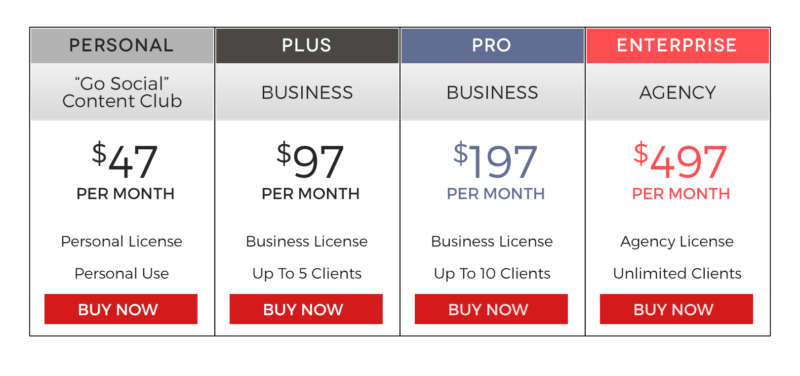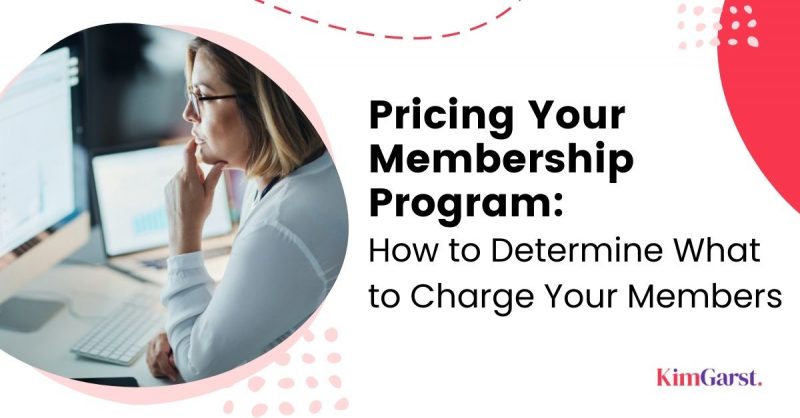Soooo…you’ve created a kick butt membership program, and are ready to start bringing in new members.
But now it’s major decision time:
How are you going to price your membership program?
Many membership site creators get really hung up on this question, because they think there’s a “right” answer.
But the truth is, there isn’t some chart or guidebook out there of standard pricing you need to stick to.
You get to decide what price makes sense for YOU and for your audience…so stop stressing, and let’s get this big ole decision done already!
In this post, I’m going to share:
4 Ways to Determine How You’re Going to Price Your Membership Program
I recommend going through each step below, and then deciding on your pricing “sweet spot” based on everything you’ve learned!
1. See What Your Competitors Are Charging

Do a Google search for “membership site” and “your niche” (e.g., cooking) to see what others are charging.
While you definitely don’t need to charge the exact same price as your competitors, you’ll probably want to at least be in the same general ballpark.
For instance, if your competitors are charging $49 month to month and you were thinking of charging $99, you would definitely need to be offering more value to stay competitive (for instance, more one-on-one time with you).
While keeping up with your competition isn’t the “be all end all” in determining the pricing of your membership program, you DO need to know generally where you fit in the competitive landscape – because, you can bet your potential customers will be researching this before they buy!
2. Determine How You Want To Position Yourself
Now that you have a feel for what your competitors are charging, you need to decide where you fit, and how you want to position yourself.
Because how much you charge says a lot about the value of what you’re offering!
[click_to_tweet tweet=”How much you charge for your membership site says a lot about the value of what you’re offering!” quote=”How much you charge for your membership site says a lot about the value of what you’re offering!” theme=”style6″]For instance, do you want to be known as a “premium” membership site? The one that costs more, but is more exclusive and higher-end? The one that attracts really successful members?
Or do you want to be known as a membership program anyone can afford – and build your membership by attracting more members who will pay a lower cost?
3. Identify Your Costs
Your monthly expenses will obviously need to factor into the pricing of your membership site as well.
Calculate your average expenses per month, which might include:
- Website hosting
- Membership management software
- Hiring someone to help with customer support
- Your email marketing service (like or Active Campaign or ConvertKit)
- Video hosting
Also be sure to factor in a reasonable profit margin for yourself!
Once you have a good feel for your average monthly costs, you can factor this in to the price of your membership program.
For instance, if you know your monthly expenses are going to be $3,000 and you anticipate having around 50 members for the first little bit, you know you’ll need to charge $60/month just to break even.
4. Decide on Pricing Tiers
At this point, you should have a general range in mind for pricing your membership program.
But you still have one step left: to determine the different pricing levels – or tiers – for your membership.
For instance, here are the pricing tiers I offer for my Go Social Content Club:

Other ways you can differentiate your tiers include:
- How long people are signing up for (monthly, quarterly, annually, or a lifetime membership)
- Level of personal support offered (e.g., a basic plan may not include any personal support, while a pro plan may include personal coaching sessions)
- Basic versus advanced features (e.g., access to a forum, extra downloads, etc.)
Keep in mind that even if you don’t anticipate many people signing up for your most basic and most expensive plan, offering pricing tiers is still a good idea!
Here’s why: Situating your standard membership option right in the middle of other options helps people understand the comparative value they’re getting.
They see that while there’s a cheaper option, the standard membership has many more features or options. And compared to the most expensive option? People can feel good that they’re getting a “deal”!
Final Thoughts
As you can see, there is no one “right” way to price your membership program.
There are many different pricing models, types of memberships, niches, and target markets, and you’ll need to consider each of these factors in your pricing.
And remember – your pricing isn’t set in stone. You simply need to decide on a base price to use right now, and then you can test this number out with your audience as you go along!
How are you going to price your membership program? Are you running into any obstacles? Let me know in the comments below!
About Author
Kim Garst
Kim Garst is a renowned marketing strategist and speaker who is trailblazing the use of artificial intelligence in digital marketing. With over 30 years of experience as an online entrepreneur, Kim helps entrepreneurs grow their business and authority online by using AI technology. She is leading the way with proven AI frameworks that help entrepreneurs build authority in their space.
She is keynote speaker and an international best-selling author of Will The Real You Please Stand Up, Show Up, Be Authentic and Prosper in Social Media.
Named by Forbes as a Top 10 Social Media Power Influencer, Kim is well-known for her skill to simplify complex technology and make the use of AI understandable for business growth. Her relatable, actionable advice helps guide new entrepreneurs to harness the power of AI to succeed in digital marketing. Kim is leading the way in combining human and technological skills to create a new model for AI-powered marketing.




3 thoughts on “Pricing Your Membership Program: How to Determine What to Charge Your Members”
Its really helpful for me
Excellent Content About Membership Programs !!!
Time, costs , expertise and program
Costs x 3 to cover additional expenses
Tangible & Intangible costs – Tax etc
Pricing very much determined by estimated uptake ( don’t undersell yourself or the course) pending on content and additional offers and exclusivity available, lifetime offer or yearly, updates, all courses or single.